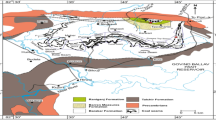Abstract
India, the world’s third largest coal producing country, is expected to maintain strong dependency on coal for the coming few decades. The gross calorific value (GCV) of coal is a key yardstick for many end users purchasing coal from suppliers, as it provides a clear measure of the useful energy content of a coal. Several methods are available to predict GCV using either moisture content and/or ash yield or using entire proximate and ultimate coal analysis data. These correlations and machine learning prediction tools tend to be too complex and hence are of limited utility for the end-user. For Indian coals, the most widely used simple correlation, based only on moisture content and ash yield, proposed by Mazumdar (1954), is less applicable to the coals being mined today, which have higher ash yields. This and other existing correlations used to predict GCV of Indian coals from moisture content and ash yield is linear in nature. Here the application of non-unitary exponents to the ash yield and moisture content terms and introducing other non-linear terms to the equation to provide empirical correlations with improved prediction accuracy for local and national application is evaluated. This evaluation is achieved in Excel using its built-in optimizer “Solver” to evaluate a generic equation and optimize its coefficients when applied to a dataset of 756 coals from three Indian coal basins and to locally focused subsets of that dataset.
Similar content being viewed by others
References
ASTM D7582 (2015) Standard Test Methods for Proximate Analysis of Coal and Coke by Macro Thermogravimetric Analysis, ASTM International, West Conshohocken, PA. https://doi.org/www.astm.org
ASTM D5865 (1996) Standard test method for gross calorific value of coal and coke.
Channiwala, S.A. and Parikh, P.P. (2002) A unified correlation for estimating HHV of solid, liquid and gaseous fuels. Fuel, v.81, pp.1051–63.
Chelgani, S.C. and Makaremi, S. (2013) Explaining the relationship between common coal analyses and Afghan coal parameters using statistical modeling methods. Fuel Processing Technology, v. 110, pp.79–85.
Dey, S., Saini, M.K., Narayan, J.P. and Chaudhury, N. (2012) Prediction of gross calorific value of Indian non-caking coals on the basis of ash and moisture. Jour. Mines, Metals & Fuels, v.60(1 & 2), pp.31–38.
Goutal, M.C.R. (1902) Acad Sci Paris; v.135, pp.477–9.
Khandelwal, M., Mahdiyar, A, Armaghani, D.J., Singh, T.N., Fahimifar, A. and Faradonbeh, R.S. (2017) An expert system based on hybrid ICA-ANN technique to estimate Macerals contents of Indian coals. Environ. Earth Sci., v.76, pp.399.
Majumder, A.K., Jain, R., Banerjee, P. and Barnwal, J.P. (2008). Development of a new proximate analysis based correlation to predict calorific value of coal. Fuel, v.87, pp.3077–3081.
Matin, S.S. and Chelgani, S.C. (2016) Estimation of coal gross calorific value based on various analyses by random forest method. Fuel, v. 177, pp.274–278.
Mazumdar, B.K. (1954) Coal systematics: deductions from proximate analysis of coal Part I. Jour. Sci. Indian Res., v.13B(12), pp.857–863.
Mazumdar, B.K. (2000) Theoretical oxygen requirement for coal combustion: relationship with its calorific value. Fuel, v. 79, pp.1413–9.
Niti Aayog (2017) Energizing India — Joint project between Niti Aayog and Institute of Energy Economics Japan (IEEJ). https://doi.org/niti.gov.in
Parikh, J., Channiwala, S.A. and Ghosal, G.K. (2005) A correlation for calculating HHV from proximate analysis of solid fuels. Fuel, v.84, pp.487–494.
Patel, S. U., Jeevan, K., Badhe, Y.P., Sharma, B. K., Saha, S., Biswas, S., Chaudhury, A., Tambe, S.S. and Kulkarni, B.D. (2007) Estimation of gross calorific value of coals using artificial neural network. Fuel, v.86, pp 334–344.
Ravi, V., Reddy, P.J. (1999) Ranking of Indian coals via fuzzy multi attribute decision making. Fuzzy Sets Syst., v. 103, pp.369–377.
Tan, P., Zhang, C., Xia, J., Fang, Q-Y. and Chen, G. (2015) Estimation of higher heating value of coal based on proximate analysis using support vector regression. Fuel Processing Technology, v.138, pp.298–304.
Wen, X., Jian, S. and Wang, J. (2017). Prediction models of calorific value of coal based on wavelet neural networks. Fuel, v. 199, pp.512–522.
Author information
Authors and Affiliations
Corresponding author
Rights and permissions
About this article
Cite this article
Kumari, P., Singh, A.K., Wood, D.A. et al. Predictions of Gross Calorific Value of Indian Coals from their Moisture and Ash Content. J Geol Soc India 93, 437–442 (2019). https://doi.org/10.1007/s12594-019-1198-5
Received:
Accepted:
Published:
Issue Date:
DOI: https://doi.org/10.1007/s12594-019-1198-5




